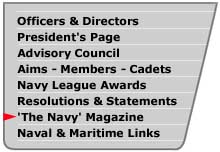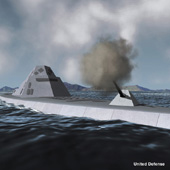 |
|
 |
|
|
OFFICIAL
JOURNAL OF NAVY LEAGUE OF AUSTRALIA All
enquiries about the magazine should be sent to - DD-21,
THE 21ST CENTURY'S DREADNOUGHT With the RAN currently studying the requirements for its new Air Warfare Destroyer THE NAVY looks at the US's own new destroyer program with the question 'what can the RAN learn from DD-21'? The U.S. Navy's 21st Century Zumwalt-class Land Attack Destroyer (DD-21) will comprise 32 ships and be the first in a family of 21st century surface combatants. This next-generation warship will be a multi-mission destroyer focused on land attack operations. DD-21 will replace aging Oliver Hazard Perry-class frigates (FFG-7) and Spruance-class destroyers (DD-963) and provide forward presence and credible deterrence while operating independently or as an integral part of a Naval, Joint, or Combined Expeditionary Force. In order to ensure effectiveness in Joint littoral operations, DD-21 will feature active and passive survivability features, such as in-stride mine avoidance capability and full-spectrum signature reduction, as well as a robust C4ISR (Command, Control, Communications, Computers, Intelligence, Surveillance Reconnaissance) suite to support the USN's evolving network-centric warfare concept. The Navy has successfully executed a competitive, price-based acquisition strategy for DD-21 that addresses 21st century Fleet requirements and takes advantage of industry's vast resources, expertise, and ingenuity. The DD-21 Program's streamlined acquisition approach seeks maximum innovation and design flexibility while facilitating cost savings through use of commercial market technologies, non-developmental items, and privatised life-cycle support. Program leaders have aggressively implemented acquisition reform initiatives and empowered industry at the earliest possible stage of the ship's concept design in order to achieve revolutionary design capabilities and substantially lower total ownership cost for DD-21. Program Status USN officials have instituted a unique acquisition approach for the Zumwalt class Land Attack Destroyer (DD-21) that provides industry with an overarching set of operational requirements and cost parameters instead of detailed design and performance specifications. This less restrictive approach encourages innovation and offers industry maximum latitude (i.e. trade space) to guide their proposals for developing, building, delivering, and supporting the 32-ship class throughout its service life. Two industry teams are competing for DD-21 - the Blue Team, led by Bath Iron Works (BIW) with Lockheed Martin Corp. as systems integrator; and the Gold Team, led by Ingalls Shipbuilding Inc. (ISI) with Raytheon Systems Co. as systems integrator. Contractual management for both teams is administered by the DD 21 Shipbuilder Alliance, a cooperative business unit formed by BIW and ISI. The USN plans to select the winning team's DD-21 System design shortly. The first ship award is scheduled for fiscal year 2005 with fleet delivery in fiscal year 2010. ZUMWALT When USS ZUMWALT, the lead ship of the DD-21 class, goes to sea in 2010 it will be just over 100 years since the Royal Navy's battleship HMS DREADOUGHT entered service. Both ships have much in common. For their time they proved to be exceptionally powerful combatants that not only introduced a range of new weaponry and tactics but also took to sea new propulsion and manning concepts. The revolutionary nature of the DREADNOUGHT made other battleships already in service obsolete. The ZUMWALT has the potential to do the same. Why
the Revolution ? Another commonality between the DREADNOUGHT and
the ZUMWALT is that both ships were produced by the pre-eminent Navy
of its time. At first glance it seems an illogical move to introduce
revolutionary new ships when you have a leading position with the status
quo fleet. But like 1905 the need for revolution today is clear and
cannot be avoided. The drivers for the radical Zumwalt design are: What will be Revolutionary about the Zumwalts ? There is much that will be new with the Zumwalts. They include: · The first destroyer specifically designed for littoral and land attack operations; · The first ship designed to conduct network centric warfare; · The first large stealth combatant; · The first major ship where the sailor is engineered into the ship from the beginning; · The first second generation electric drive combatant; · The first third generation phased array destroyer. A Closer Look at the Zumwalts Manning
Whether the Zumwalts are able to operate with 95 personnel is questionable.
But what is clear is that their crew size will be dramatically smaller
than the DDG-51 class of destroyers. How will this be achieved? Top
down human systems integration (HIS) is vital. A fresh look at the myriad
of shipboard activities combined with providing the dollars to come
up with hardware or software solutions will lead to fewer personnel
required for watchkeeping, replenishment evolutions and maintenance.
At the same time the need to retain people in the Navy will be addressed
by vastly improved living conditions (two berth cabins, gyms, satellite
entertainment and training facilities) and reducing the need for laborious
cleaning, painting and watchstanding.
DD-21 and the RAN While
the DD21 would be an impressive addition to the RAN, at a sail away
price of $US750m each, it is problematic whether it would ever fly the
Australian White Ensign from its quarterdeck. Nevertheless the Zumwalt
will have a profound effect on the RAN in two ways. First it will likely
introduce and debug some systems may be fitted to the RAN's Air Warfare
Destroyer and future ships. More importantly though the Zumwalt shows
that:
|
|

